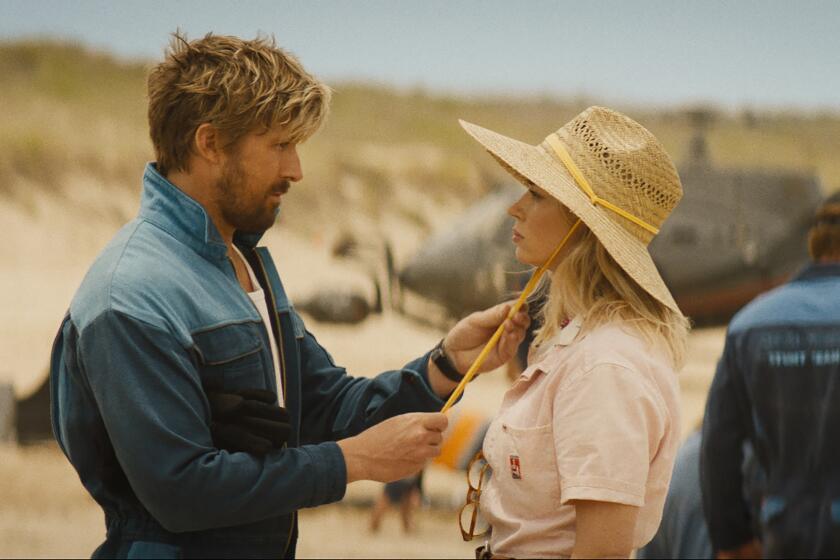His final steps
Short of someone inventing Smell-o-Vision before Oct. 28’s global rollout of the feature documentary “Michael Jackson’s This Is It,” fans will never get to know one of the most visceral aspects of working with the King of Pop.
“He had this amazing fragrance,” said Mekia Cox, one of 11 backup dancers who worked with Jackson between April and June on “This Is It,” his series of 50 sold-out concerts scheduled to start taking place at London’s O2 Arena over the summer. The shows would have marked the superstar’s return to performing after a 12-year touring absence.
Another dancer, Daniel Celebre, referred to Jackson’s singular musk as “the love potion,” recalling its ability to trigger an almost Pavlovian response in those downwind. “No matter what you’re doing, as soon as you smell that smell, boom! You have to get more focused,” Celebre recalled. “Because he needs to know we’re having that love. And throwing the love around.”
It’s not uncommon for those who worked with Jackson in his final months to speak about the entertainer in emotionally overheated terms. Several close collaborators on what was being touted as Jackson’s final tour -- a concert extravaganza that could have resurrected his finances, reestablished his cultural relevancy and spread messages of global interconnectivity, love and environmentalism -- seem to have gotten swept up in his grandiose vision. It’s one that would have involved elaborate aerial dance numbers, the world’s largest three-dimensional LCD screen, pyrotechnic illusions, 12 original short films and even the presence of a bulldozer and a children’s choir onstage.
With the release of “Michael Jackson’s This Is It” next week for a limited two-week theatrical engagement, his fans and doubters alike can see a nearly actualized version of that vision for themselves. To hear it from those who worked on “This Is It,” the film will provide new insight into the private Jackson that few outside his inner circle ever see.
“Michael was a new Michael,” said “This Is It” concert director Kenny Ortega, who also directed the film. “He was 12 years a dad, a businessman, an entertainer’s entertainer. That wonderful, innocent part of Michael was ever present, but there was another Michael there with more worldly concerns. He had deeper reasons for wanting to do this than I’ve ever seen for him to want to do anything else before.”
Consisting of digital video footage shot in rehearsals during the weeks before the production moved to London for final run-throughs, the movie also will throw Jackson’s physical and mental bearing into stark relief -- at a time when many are still struggling to understand the circumstances surrounding his death. Jackson, 50, died of acute intoxication by the anesthetic propofol on June 25, and according to his autopsy, he also had been taking a laundry list of sedatives, anti-anxiety medications and painkillers.
Some people who worked with the entertainer daily, however, insist there were no outward signs of his drug dependence.
“He was on a whole new level,” said backup dancer Dres Reid. “When you saw Mike, it was a different Michael. He had a swagger about him.”
Ortega directed the singer’s “HIStory” and “Dangerous” tours in the ‘90s and is the force behind the “High School Musical” franchise and the “Hannah Montana/Miley Cyrus: Best of Both Worlds Concert Tour.” The director had been in talks with Jackson for more than two years about mounting some kind of performance. Yet Jackson had held out for a “substantial reason” to return to performing, Ortega said.
In March, Jackson called Ortega with news that he had signed to mount a series of concerts with promoter AEG Live.
“He started saying, ‘Kenny, my kids are so fascinated with what I’ve been doing my whole life, they’re like super-fans. So I want to share with my children now that they’re old enough to appreciate it and I’m still young enough to do it,’ ” Ortega recalled.
The superstar intended his concerts as payback to fans and a platform to broadcast his concerns. “The messages in my songs, the ones I wrote 10 years ago, are more meaningful today,” Ortega quoted Jackson as saying.
Associate director Travis Payne, a choreographer who had worked with Jackson on world tours and music videos since the early ‘90s, said: “This was to be the biggest platform possible for him to refamiliarize the messages that had been in his music and films for years. . . . Michael was going to remind everyone of the job we have to complete with regard to reversing our damage to the planet.”
Although the pop icon was about $400 million in debt heading into “This Is It,” Ortega insists their conversations never broached Jackson’s financial predicament. Nor, despite Jackson’s long absence from the world’s stages, did the word “comeback” factor into their discussions.
“One time, I said to Michael, ‘You’re going to get your crown back. I can’t wait,’ ” Ortega said. “Michael just giggled at me. ‘God bless you, Kenny. You’re so funny.’ He just didn’t think that way.”
“Michael Jackson’s This Is It” will showcase a dimension of the performer that falls well outside the prevailing images of one of the most photographed men of the last half-century. Whether your notion of Jackson is as the surgical mask-wearing eccentric who was acquitted in a 2005 criminal trial on child molestation charges, the guy who dangled his baby over a hotel balcony, or the man who moonwalked across the stage during his epochal 1983 “Motown 25” performance and urged the world to “look at yourself to make a change” -- the movie presents a competing notion of the “Thriller” singer. Jackson as the boss, a perfectionist and creative visionary who was personally invested in the smallest details of his show.
“If he was in the middle of a dance number and something wasn’t right, he’d say, ‘Stop!’ Everything would come to a stop,” Ortega said. “And he’d say, ‘Don’t do that! Wait for me. Watch me.’ And remind people that this wasn’t an automatic production. You don’t just push buttons. You watch Michael.”
Cox said: “He was commanding.”
“As much as he’d fire off what was on his mind at the time, he’d still have a light gesture at the end,” added fellow backup dancer Shannon Holtzpffel. “But he’d be very direct. And we’d be like, ‘Wow.’ ”
According to those close to him, Jackson’s exacting nature took a physical toll on him that is visible in the film. Ortega said the singer had been losing weight and grew fatigued from missing more and more sleep as the production’s London deadline neared. Both Payne and Ortega spoke of Jackson’s penchant for rehearsing until as late as 1 a.m. and then calling them around 4 to brainstorm new ideas.
“He didn’t sleep a lot,” said Ortega, who like many others interviewed by The Times said he had no idea that Jackson had a drug dependency. “He had been losing weight and didn’t like to eat much when he was in my company. It was always, ‘I’m dancing. I don’t want to eat.’
“I discussed it with him, with his doctor, with his team. I was really concerned about Michael getting the proper rest, the proper nourishment. We were told -- and Michael assured me -- that he was in good health,” he said.
Payne, who had gotten to know the singer’s professional M.O. working with Jackson on his “Dangerous” and “HIStory” tours, made sure to have Boost meal replacement shakes, Orangina and Martinelli’s apple cider on hand to keep Jackson replenished.
“He’d go for periods of time without eating or sleeping because he was so immersed in what we were doing,” Payne said.
Nonetheless, Ortega remains resolute that “This Is It” was nothing but a “nourishing” experience for the entertainer, not the cause of his demise. And that for Jackson fans -- for that matter, anyone curious about Jackson’s final days -- the movie can still offer a meaningful interface with the King of Pop.
“The movie is dedicated to Michael’s fans and his children,” said Ortega. “But he’s so alive and present in this movie, when we were in the editing room, there were times I’d forgotten he was no longer with us. . . . He’s so big, so engaging. He draws you in. And I think there is a fascination that will go beyond the fans.”
--
More to Read
The biggest entertainment stories
Get our big stories about Hollywood, film, television, music, arts, culture and more right in your inbox as soon as they publish.
You may occasionally receive promotional content from the Los Angeles Times.







